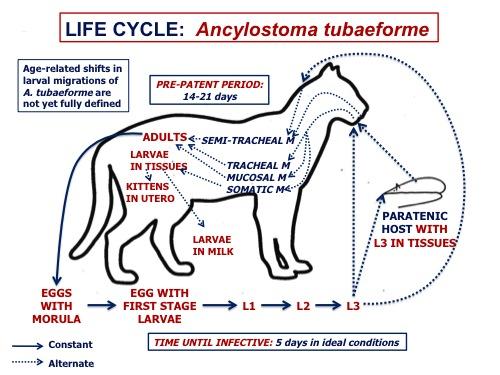Ancylostoma tubaeforme
The nematode Ancylostoma tubaeforme is a hookworm of cats that occurs around the world. Infection with A. tubaeforme is rarely diagnosed in cats in Canada.
Summary
Taxonomy
Phylum: Nematoda
Class: Secernentea
Order: Strongylida
Superfamily: Ancylostomatoidea Family: Ancylostomatidae
Ancylostoma tubaeforme is one of the hookworms of cats. It is related to the hookworm of dogs and cats (A. ceylanicum), and also to the hookworms of dogs (Ancylostoma caninum, and A. braziliense), and of people (A. duodenale and Necator americanus). The adult parasites and the eggs of these various hookworm species are morphologically similar, and the life cycles and pathology share many features. Some species of hookworm are able to infect several species of host, including people.
Morphology
Host range and geographic distribution
Life cycle - direct
The life cycle of A. tubaeforme is direct. Cats may become infected through ingestion or skin penetration of third stage larvae in the environment (subsequently following mucosal or semi-tracheal migration routes, respectively), or ingestion of third stage larvae in paratenic hosts (subsequently following a mucosal migration). The relative importance of these transmission routes is not known. The pre-patent period is 2-4 weeks. There is no evidence of prenatal or transmammary transmission.
essentially similar to A. caninum in dogs. There is no evidence of prenatal or transmammary transmission.

Epidemiology
Pathology and clinical signs
Diagnosis
Treatment and control
Ancylostoma tubaeforme is rare in cats in Canada, and therefore treatment is rarely indicated. Several products are, however, approved in Canada for this parasite. Resistance is not yet documented for hookworm in cats, in contrast with dogs.
Control of A. tubaeforme depends upon dealing with the sources of infection. This means treating any “carrier” animals, especially the mothers of young kittens, and aggressively treating the kittens if they show any evidence of hookworm disease. The free-living stages of A. tubaeforme (eggs and larvae) are susceptible to thorough cleaning with a disinfectant. Limiting the animals’ access to areas potentially contaminated with infective larvae and to parantetic hosts is also helpful.

